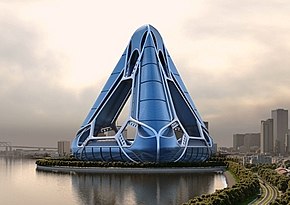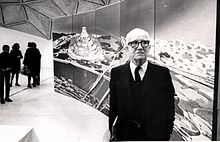
Paolo Soleri was an Italian-born American architect and urban planner. He established the educational Cosanti Foundation and Arcosanti. Soleri was a lecturer in the College of Architecture at Arizona State University and a National Design Award recipient in 2006. He coined the concept of 'arcology' – a synthesis of architecture and ecology as the philosophy of democratic society. He died at home of natural causes on 9 April 2013 at the age of 93.

Arcosanti is an experimental town with a bronze bell casting business in Yavapai County, central Arizona, United States, 70 mi (110 km) north of Phoenix, at an elevation of 3,732 feet (1,138 m). Its arcology concept was proposed by Italian-American architect Paolo Soleri (1919–2013). He began construction in 1970 to demonstrate how urban conditions could be improved while minimizing the destructive impact on the Earth. He taught and influenced generations of architects and urban designers who studied and worked with him there to build the proposed town.

Cosanti is the gallery and studio of Italian-American architect Paolo Soleri; it was his residence until his death in 2013. Located in Paradise Valley, Arizona, USA, it has become an Arizona Historic Site open to the public. Cosanti is marked by terraced landscaping, experimental earth-formed concrete structures, and sculptural wind-bells.
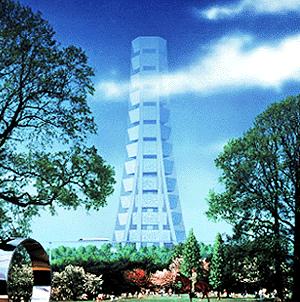
Sky City 1000 is a proposed skyscraper for the Tokyo metropolitan area. It was announced in 1989 at the height of the Japanese asset price bubble.
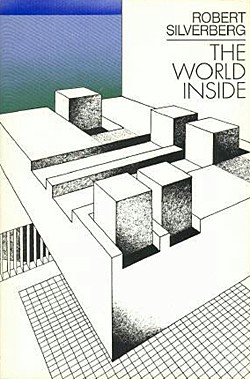
The World Inside is a science fiction novel by American writer Robert Silverberg, published in 1971. The novel originally appeared as a series of shorter works in 1970 and 1971, all but one published in Galaxy, including the Hugo nominated novella "The World Outside". The World Inside was nominated for a Hugo Award in 1972, although Silverberg declined the nomination.
Will Bruder is an American architect.

The Shimizu TRY 2004 Mega-City Pyramid is a proposed Shimizu Corporation project for the construction of a massive self-sustaining arcology-pyramid over Tokyo Bay in Japan that would have businesses, parks, and other services contained within the building. The structure would house 1,000,000 people. The structure would be 2,004 meters high, including five stacked trusses, each with similar dimensions to that of the Great Pyramid of Giza. This pyramid would help answer Tokyo's increasing lack of space, although the project would only handle a small fraction of the population of the Greater Tokyo Area.

Saudi Arabia is the second biggest tourist destination in the Middle East with over 16 million visiting in 2017. Although most tourism in Saudi Arabia still largely involves religious pilgrimages, there is growth in the leisure tourism sector. As the tourism sector has been largely boosted lately, the sector is expected to a significant industry for Saudi Arabia, reducing its dependence on oil revenues. This is proved as tourism sector is expected to generate $25 billion in 2019. Potential tourist areas include the Hijaz and Sarawat Mountains, Red Sea diving and a number of ancient ruins.

The Howeitat or Huwaitat are a large Judhami tribe that inhabits areas of present-day southern Jordan, the Sinai Peninsula and Sharqia governate in Egypt, the Negev, and northwestern Saudi Arabia. The Howeitat have several branches, notably the Ibn Jazi, the Abu Tayi, the Anjaddat, and the Sulaymanniyin, in addition to a number of associated tribes.

The Saudi–Egypt Causeway is a proposal to link Egypt and Saudi Arabia with a causeway and bridge.
Prince Abdulaziz Bin Mousaed Economic City (PABMEC) is a proposed planned city in Saudi Arabia. Saudi Arabia.
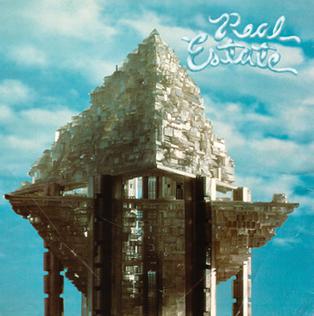
Real Estate is the debut album by American indie rock band Real Estate, released on November 17, 2009 on Woodsist.

Ziggurat Pyramid is a pyramid-shaped arcology that was conceived for Dubai in 2008. It was estimated to start construction in 2021 and be completed by 2028.
The desert-covered Kingdom of Saudi Arabia is the geographically largest country in the Middle East. Moreover, it accounts for 65% of the overall population of the GCC countries and 42% of its GDP. Saudi Arabia does not have a strong history in environmentalism. Thus, as the number of population increases and the industrial activity grows, environmental issues pose a real challenge to the country.

Neom is a new urban area being built by Saudi Arabia in Tabuk. Launched in 2017 by crown prince Bin Salman, the site is at the northern tip of the Red Sea, due east of Egypt across the Gulf of Aqaba and south of Jordan. The total planned area of Neom is 26,500 km2 (10,200 sq mi). Multiple regions are planned, including a floating industrial complex, global trade hub, tourist resorts and a linear city powered by renewable energy sources.

Qiddiya is a planned entertainment and tourism megaproject in Riyadh, Saudi Arabia. Construction started in the beginning of 2019. It planned to open in 2023. It is part of the Saudi Vision 2030 program, which aims to diversify the Saudi economy.
The Line is a linear smart city under construction in Saudi Arabia in Neom, Tabuk Province, which is designed to have no cars, streets or carbon emissions.
The Arizona Cancer Center Chapel also known as the Soleri Chapel or the "De Bonis Chapel" is a distinctive architectural resource located within the University of Arizona Cancer Center at 1515 North Campbell Avenue in Tucson, Arizona. Designed by the internationally renowned Italian-American architect Paolo Soleri and built in 1986, the chapel reflects Soleri's vision and commitment to blending art, architecture, and nature. The late twentieth-century design is a rare example of Soleri's architectural work in southern Arizona.
